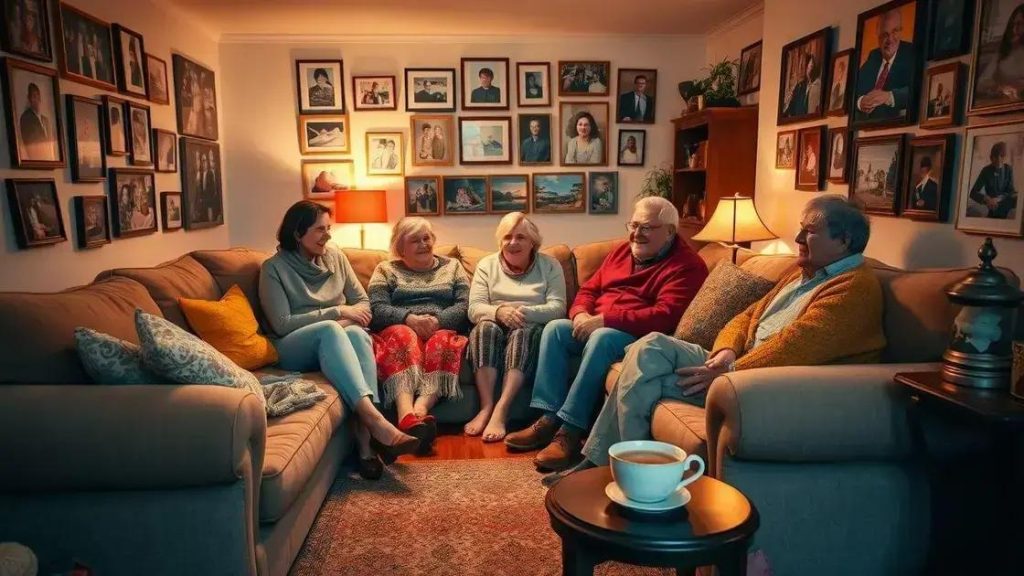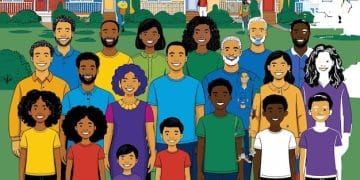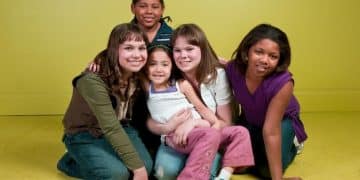Multigenerational household trends shaping modern living

Multigenerational household trends reflect a growing preference for shared living, providing financial savings, emotional support, and the potential for stronger family bonds, while also presenting challenges like communication gaps and the need for personal space.
Multigenerational household trends are becoming increasingly common, especially in today’s fast-paced world. Have you noticed how families are redefining their living arrangements? Let’s dive into this fascinating topic.
Understanding multigenerational households
Understanding multigenerational households is essential as more families choose this living arrangement. It’s not just about sharing space; it’s about embracing a new lifestyle that brings families closer together.
Historically, many cultures have valued extended family living. Today, factors like rising housing costs and changing family dynamics are driving this trend. Families today are opting to live together for emotional and financial support.
Benefits of Multigenerational Living
Multigenerational households offer various advantages. These include:
- Shared expenses: Families can save money by splitting costs like rent and utilities.
- Emotional support: Having loved ones nearby can reduce feelings of loneliness.
- Childcare assistance: Grandparents can help with childcare, making it easier for parents to work.
Another reason for this trend is the chance to bond deeply as a family. Being in close quarters often leads to more shared experiences and lasting memories. For many, it’s about building a stronger family unit.
Challenges do exist, though. Privacy can be difficult to maintain in a shared space. It’s important for families to establish boundaries to ensure everyone feels comfortable. Communication is key when living under one roof, as misunderstandings can arise if family members are not open about their needs.
Key Challenges in Multigenerational Households
Some common issues faced in these households are:
- Space constraints: Finding a home that accommodates everyone can be a challenge.
- Different lifestyles: Conflicts may arise from differing routines and habits.
- Cultural differences: Families with diverse backgrounds may experience clashes in traditions and values.
Large families may need to be more flexible regarding their space and routines. Setting clear expectations and having regular check-ins can help resolve conflicts effectively. Embracing the strengths of all family members can lead to a harmonious living environment.
The benefits of living with extended family

Living with extended family offers numerous advantages that can enhance the quality of life for everyone involved. As traditional family structures evolve, more families are discovering the benefits of sharing a home with grandparents, aunts, uncles, and cousins.
One major benefit is the financial relief it provides. By pooling resources, families can reduce individual expenses, making housing more affordable. This arrangement can especially help during tough economic times.
Emotional and Social Support
Extended families also offer robust emotional support. Having family members close by means you always have someone to turn to. This can be especially important for parents raising children or those facing life’s challenges.
- Increased interaction: Regular family gatherings help strengthen bonds.
- Shared responsibilities: Family members can share childcare duties, helping parents balance work and home life.
- Learning opportunities: Children gain knowledge and life skills from older family members.
Furthermore, living together fosters a sense of community and belonging. Families often create traditions that involve everyone, from weekly dinners to game nights. These activities can deepen connections and create lasting memories. When families communicate openly, they can address issues swiftly and maintain harmony in the household.
Practical Benefits
There are also many practical advantages of multigenerational living. For instance, the sharing of household chores can help ease daily burdens. This can free up time for activities that strengthen family ties. Creating a supportive environment encourages everyone to excel in their personal and professional lives.
On a practical note, living with extended family can provide help in emergency situations. Whether it’s caring for a sick family member or dealing with unexpected financial strains, having family nearby can make tough times more manageable. It can also promote healthier living, as families often prioritize shared meals and physical activities together.
Challenges faced in multigenerational setups
Living in a multigenerational setup can be rewarding, but it also comes with unique challenges. As families navigate shared spaces and responsibilities, conflicts can arise that require attention and communication.
One common issue is the struggle for personal space. In a home filled with family members, finding a quiet area to recharge can be difficult. This often leads to feelings of being overwhelmed or cramped. It’s important for each member to express their need for space and respect the boundaries of others.
Communication Challenges
Another challenge is effective communication. Different generations may have varying communication styles, which can lead to misunderstandings. Open dialogue is crucial for addressing issues before they escalate.
- Generational gaps: Older family members may prefer traditional methods of communication, while younger members might favor technology.
- Conflict resolution: Finding a common ground for resolving disputes can be tricky.
- Addressing needs: Each generation has different priorities that must be acknowledged.
Financial stress can also be a significant challenge in multigenerational households. Sharing expenses often means that financial responsibilities are spread across multiple incomes, yet conflicts may arise over spending habits. To mitigate this, families should establish clear financial agreements to keep misunderstandings at bay.
Balancing Responsibilities
Balancing household responsibilities is critical, too. Family members might struggle with an uneven distribution of chores, which can lead to resentment. Regular family meetings to discuss household tasks can help ensure that everyone feels heard and valued.
While there are challenges to living in a multigenerational household, working together to address these issues can strengthen family bonds. It requires commitment and effort but can lead to a more cohesive family unit in the long run.
Future predictions for household trends

The future predictions for household trends indicate significant changes in how families will live together. With shifting societal norms and economic factors, many anticipate more diverse living arrangements.
One noticeable trend is the increase in remote work. As more people work from home, the need for suitable living spaces that accommodate both work and family life will grow. Many homes may be designed with dedicated office spaces, allowing family members to balance their professional and personal lives efficiently.
Adaptation of Living Spaces
Homes will likely be reimagined to support multigenerational living. This means more flexible floor plans that can adapt to changing family needs. Features such as separate entrances, in-law suites, and shared common areas may become more common.
- Eco-friendly designs: Sustainable home features that reduce energy consumption will gain popularity.
- Smart technology: Homes will be equipped with smart devices that enhance security and convenience.
- Health-focused design: Homes may be designed to promote wellness, with spaces for exercise and relaxation.
Another prediction is the rise in communal living arrangements. As housing prices continue to soar, families might look for ways to share living costs through co-housing or extended family living. This can lead to greater social interaction and support among residents.
Impact of Technology
Technology will undoubtedly change household dynamics. More families will use apps and online platforms to manage household tasks and communicate. Additionally, smart home systems will provide safety and ease of living, making it easier for families to monitor their home environments.
As society continues to evolve, these trends may lead to a more interconnected and supportive family lifestyle. Embracing these changes can help families thrive in their unique environments.
In conclusion, the trends in multigenerational households are reshaping how families live together. The benefits include financial savings, emotional support, and shared responsibilities. However, challenges such as communication gaps and the need for personal space can arise. As we look to the future, advancements in technology and changing lifestyles will likely lead to more innovative living arrangements. Embracing these shifts can create stronger family bonds, fostering a supportive and cooperative environment for all members.
FAQ – Common Questions About Multigenerational Households
What are the benefits of living in a multigenerational household?
Living in a multigenerational household offers financial savings, emotional support, and shared responsibilities, which can enhance family dynamics.
What challenges might arise in multigenerational living?
Challenges can include communication gaps, the need for personal space, and balancing household responsibilities among family members.
How will technology impact future multigenerational households?
Technology will likely lead to homes equipped with smart devices and tools that facilitate communication and task management, making life easier for families.
What are some future trends for multigenerational living?
Future trends may include more flexible living spaces, eco-friendly designs, and the rise of communal living arrangements to address housing needs.





